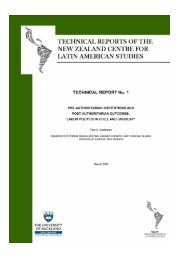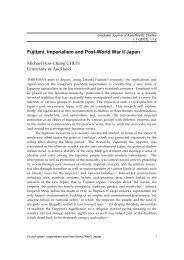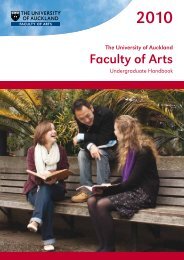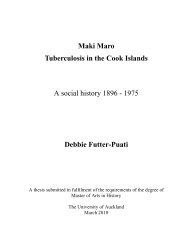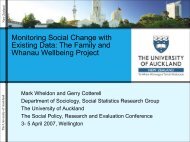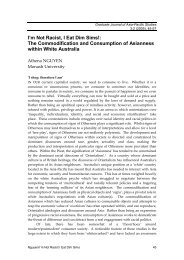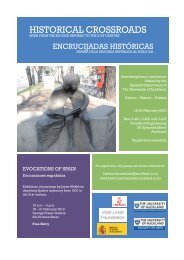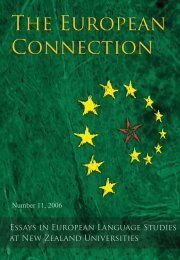You also want an ePaper? Increase the reach of your titles
YUMPU automatically turns print PDFs into web optimized ePapers that Google loves.
For instance, italicized phrases deploying <strong>the</strong> voice and apprehension <strong>of</strong> <strong>the</strong> child<br />
Tama at an earlier family tangi have been downplayed in <strong>the</strong> later version.<br />
‘Tangi’ can justifiably claim passages <strong>of</strong> great lyric beauty. As <strong>the</strong> casket is<br />
lowered into <strong>the</strong> earth an analogy is made between <strong>the</strong> separation <strong>of</strong> husband and<br />
wife and <strong>the</strong> separation <strong>of</strong> <strong>the</strong> mythic parents Ranginui and Papatūānuku. The passage<br />
quoted here is taken from <strong>the</strong> earlier publication:<br />
‘Earth reaches for Sky and Sky bends to Earth. One last fierce clasp in rain and wind<br />
and wind and rain. One last embrace <strong>of</strong> rage and fury and helpless grief. One last<br />
clinging <strong>of</strong> body to body, <strong>of</strong> Earth to Sky. One last meeting <strong>of</strong> lips to lips and tears to<br />
tears.<br />
And <strong>the</strong>n <strong>the</strong> slow drawing away, <strong>the</strong> slow tearing away, <strong>the</strong> slow wrenching away <strong>of</strong><br />
Sky from Earth, <strong>of</strong> Earth from Sky, in <strong>the</strong> final, sorrowful separation . . .<br />
Farewell, e pa. Haere ra, my fa<strong>the</strong>r’. 4<br />
This version allowed me to refer in a previous critique to a ‘melancholia<br />
subsumed by a depth <strong>of</strong> grief and rage so pr<strong>of</strong>ound it assumes cosmic proportions‘.<br />
Through marginal changes to <strong>the</strong> revised text in <strong>the</strong> <strong>rope</strong> <strong>of</strong> <strong>man</strong> <strong>the</strong> word ‘fierce’<br />
becomes ‘passionate’ and ‘One last fierce clasp in rain and wind and wind and rain’<br />
is replaced by ‘One last embrace <strong>of</strong> joy and love and thankfulness’. 5 Perhaps<br />
intended to suggest a hope for healing <strong>the</strong> sentimental underlay in this revision is<br />
unequivocally absent in <strong>the</strong> original. In contrast a later exchange between mo<strong>the</strong>r<br />
and son in ‘The Return’ is almost tongue‐in‐cheek – ‘But sometimes I can become<br />
maudlin. Her words set me <strong>of</strong>f again and, when she saw I was still sorrowing, she<br />
got cross. “Oh, get over yourself,” she said’. 6<br />
In <strong>the</strong> <strong>rope</strong> <strong>of</strong> <strong>man</strong> <strong>the</strong> prevailing metaphor is streng<strong>the</strong>ned by ano<strong>the</strong>r<br />
whakataukii, or proverb: ‘Te torino haere whakamua, whakamuri. At <strong>the</strong> same time as<br />
<strong>the</strong> spiral is going forward, it is returning’. 7 Elsewhere, <strong>Ihimaera</strong> has referred to <strong>the</strong><br />
double spiral which allows you ‘to go back into history and <strong>the</strong>n come out again.<br />
Back from personal into political . . . [and] out again’. 8 The spiral is a t<strong>rope</strong> with a<br />
trajectory founded on Māori ways <strong>of</strong> perceiving <strong>the</strong> world and our place in it. One <strong>of</strong><br />
<strong>the</strong> distinctive aspects <strong>of</strong> <strong>the</strong> spiral formation is <strong>the</strong> seamless transition it influences<br />
between past and present, and between temporal and spatial. This sense <strong>of</strong> travelling<br />
between two worlds is heightened by imaginative depictions <strong>of</strong> <strong>the</strong> landscape seen<br />
through <strong>the</strong> windows <strong>of</strong> <strong>the</strong> train carrying <strong>the</strong> narrator to and from Wellington: ‘The<br />
train curves into <strong>the</strong> dark bleakness ahead, breaking through <strong>the</strong> rain. The carriage<br />
rocks and sways like a canoe adrift. The mountains are <strong>the</strong> ridged backbone <strong>of</strong> a<br />
giant fish’. 9<br />
Here, <strong>Ihimaera</strong>’s ability to integrate a mythic past into <strong>the</strong> text, in this instance<br />
Māui’s lifting <strong>of</strong> Aotearoa 10 from <strong>the</strong> ocean, validates <strong>the</strong> notion <strong>of</strong> a narrator with a<br />
lineage recorded in <strong>the</strong> contours <strong>of</strong> <strong>the</strong> earth – ‘My mo<strong>the</strong>r was <strong>the</strong> Earth. My fa<strong>the</strong>r<br />
was <strong>the</strong> Sky’. 11 Similar perceptions underline Tama’s wait for <strong>the</strong> flood <strong>of</strong> light to <strong>the</strong><br />
east <strong>of</strong> <strong>the</strong> plane when, returning from London with sleeping passengers around<br />
him, his karakia 12 echoes his fa<strong>the</strong>r’s salutation to <strong>the</strong> day which was ‘also a prayer:<br />
Ko Ranginui kei runga, ko Papatuanuku kei raro, tena korua’. 13<br />
Cultural beliefs such as <strong>the</strong>se sit comfortably with <strong>the</strong> writer’s ‘mind style’ 14 or<br />
habitual way <strong>of</strong> viewing <strong>the</strong> world. <strong>Ihimaera</strong> frequently expresses varying psychic<br />
118<br />
www.arts.auckland.ac.nz/gjaps




